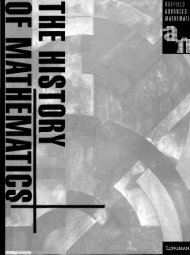Louis Pasteur by Nicola Kingsley - National STEM Centre
Louis Pasteur by Nicola Kingsley - National STEM Centre
Louis Pasteur by Nicola Kingsley - National STEM Centre
Create successful ePaper yourself
Turn your PDF publications into a flip-book with our unique Google optimized e-Paper software.
A drop of pond<br />
water magnified<br />
to show various<br />
micro-organisms<br />
14<br />
butterflies. Using a magnifying glass he looked for, and<br />
found, the eggs.<br />
A few years later, in 1677,a shopkeeper in the Netherlands,<br />
Anton van Leeuwenhoek looked through a microscope,<br />
which he had made in his spare time, at a drop of pond<br />
water. He discovered lots of tiny living things, which<br />
nobody had suspected. A few years later he made a better<br />
microscope that allowed him to just make out even tinier<br />
dots and rods, which he thought might also be alive. He<br />
had found the type of microbe that was later given the<br />
name "bacteria".<br />
Biologists wondered if the microbes van Leeuwenhoek had<br />
found arose, like maggots, from something else that was<br />
alive, or if they appeared <strong>by</strong> spontaneous generation. They<br />
discussed the matter for years. Then in 1748 an English<br />
biologist, John Needham, set up an experiment which he<br />
hoped would provide an answer. He took some mutton soup<br />
and boiled it for a few minutes to kill any microbes in it.<br />
Then he put the soup in a container which he sealed<br />
tightly to stop any fresh microbes getting in. After a few<br />
days he opened the container and found the soup swarming<br />
with microbes. He decided they must have arisen from the<br />
soup <strong>by</strong> spontaneous generation.

















